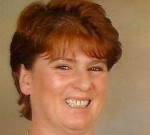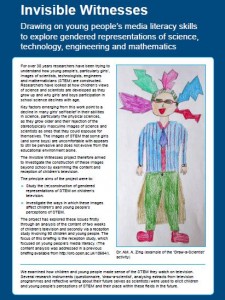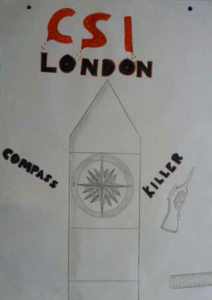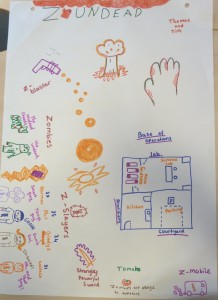Can you imagine a scientist? Alternatively, can you imagine yourself working as a scientist? These are questions that Liz Whitelegg, Richard Holliman and myself, all members of the Invisible Witnesses team, have been asking school students.
Most recently, this involved a workshop with Year 7 students at Denbigh Teaching School in Milton Keynes. The workshop was designed to encourage the students to draw on their media literacy skills to explore the ways in which media representations of scientists and the sciences might influence their interpretation of the nature and value of science and the role it might play in their lives.
Media Literacy
A key principle underpinning the workshop activities, and the Invisible Witnesses project as a whole, was that children and young people are not simply passive receivers of media messages. Rather, they are active viewers and interpreters of media representations with the power to respond creatively to them.
The workshop activities at Denbigh School focused on the media literacy skills of: Accessing, Understanding and Creating.
The first activity of the day involved the students watching a series of clips from television series that featured representations of science and scientists. Happily, three of the programmes identified through a questionnaire completed by the pupils were included in the clips we had prepared. From previous workshops, we found these clips to be a good basis for stimulating discussion.
The students were able to demonstrate a good understanding of the ways in which programme-makers use ‘short-cuts’ to establish the stereotypical roles of characters within the programmes.
The next activity was designed to encourage the students to engage with the ‘create’ aspect of their media literacy skills. Working in small groups, they designed a television series that they believed would encourage children and young people to take an active interest in the sciences.
The series created by the students were Dr Radiation (a cartoon), Ask Science (non-fiction show where topics are explored through experiments), and two drama series CSI London – the compass killer and Z Undead.
Dr Radiation
Dr Radiation was a ‘big budget’ production, with the students planning to have the characters’ voices provided by famous actors - Adam Sandler, Chris Rock, Johnny Depp and Selena Gomez!
The series centres on the character of Robert, who takes part in a science competition, but his experiment “goes wrong” and he transforms into Dr Radiation, the world’s greatest scientist, complete with super powers.
The students insisted that the fictional nature of the programme shouldn’t mean that the science shown shouldn’t be “real” – viewers should find the programme funny, but they should still learn about science.
Ask Science
This focus on ‘funny but informative’ has been evident in series created by participants in previous workshops, but was also illustrated in the description of the presenters for the series Ask Science.
The students wanted the presenters to be “funny, but not clowny”. They felt this could be achieved if the presenters were a mix of “famous scientists and famous ‘normal’ people”. The ‘normal’ in this instance meant Emma Watson and Will.I.Am. The famous scientists given as possible presenters were Brian Cox and “the female mathematician”, whose name they, rather worryingly, couldn’t remember.
One aspect of the show that was emphasised by the students in relation to young people finding it engaging was that it should not take place in a laboratory, but “out on the streets”. The students also envisaged that viewers would be able to interact with the programme by answering questions online that tested their understanding of the experiments conducted and the topics discussed.
Drama: CSI London and Z Undead
In designing the two drama series the students drew on an existing popular format (CSI London – the compass killer) and the recently-released film World War Z (Z Undead).
In addition to the forensic science focused on in all CSI series, the students added an additional element to the storyline for this particular series. At set times the clock face of Big Ben would turn into compass and the detectives would be given numerical clues that related to the direction indicated on the compass, which they could use to work out where the next murder would take place. To be able to achieve this the detectives would have to be “good at maths”.
Z Undead draws on the narrative of ‘scientist as hero’, again a narrative that has featured prominently in series designed by other participants in previous workshops. This series also highlights the potential for science fiction programmes to provide positive representations of science and scientists within stories that young people find engaging.
The importance of creativity
The young people that took part in the workshop demonstrated sophisticated media literacy skills through creativity – the ability to draw on genre and narratives that are appealing to audiences of their age and younger whilst simultaneously linking to science content that has the potential to inform, educate and entertain their target audience.
If you would like further details about how you might provide opportunities for young people to think creatively about their engagement with science, worksheets and resources related to these activities and others carried out as part of the Invisible Witness project are available as appendices to our project reports (Whitelegg et al., 2008; Carr et al., 2009).
You could also download a copy of a Teaching Resource produced by the project team.




